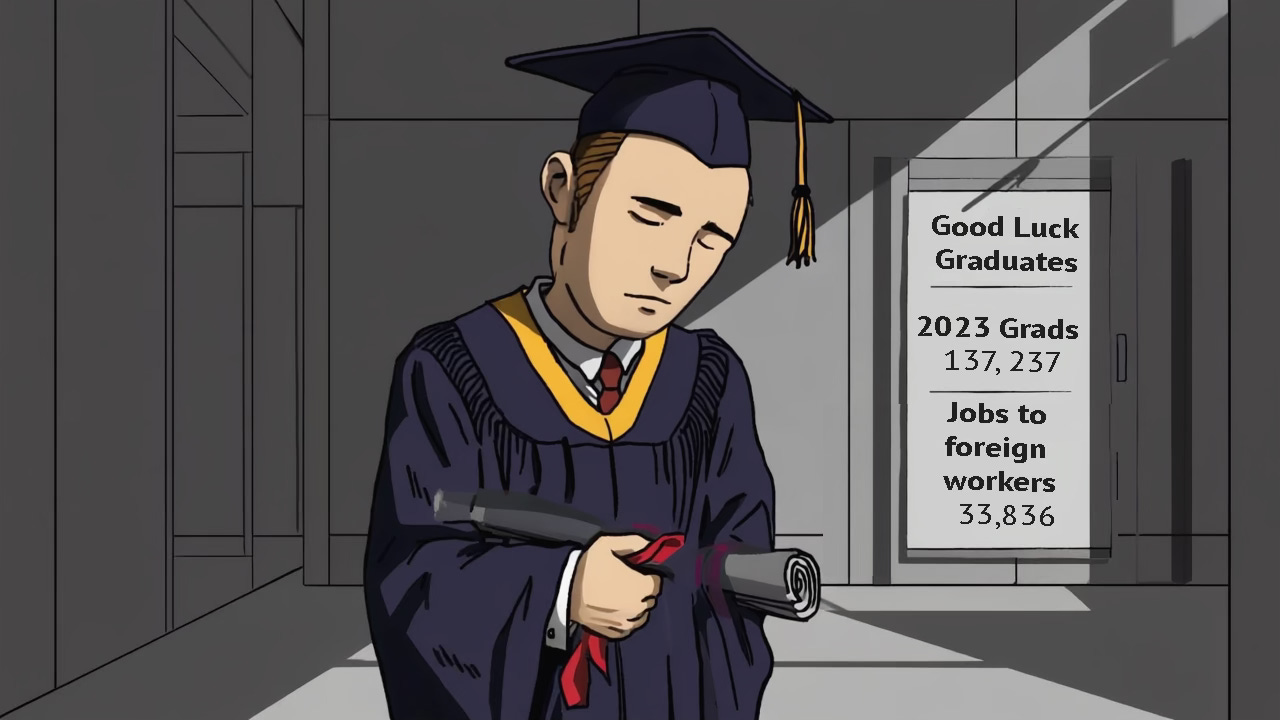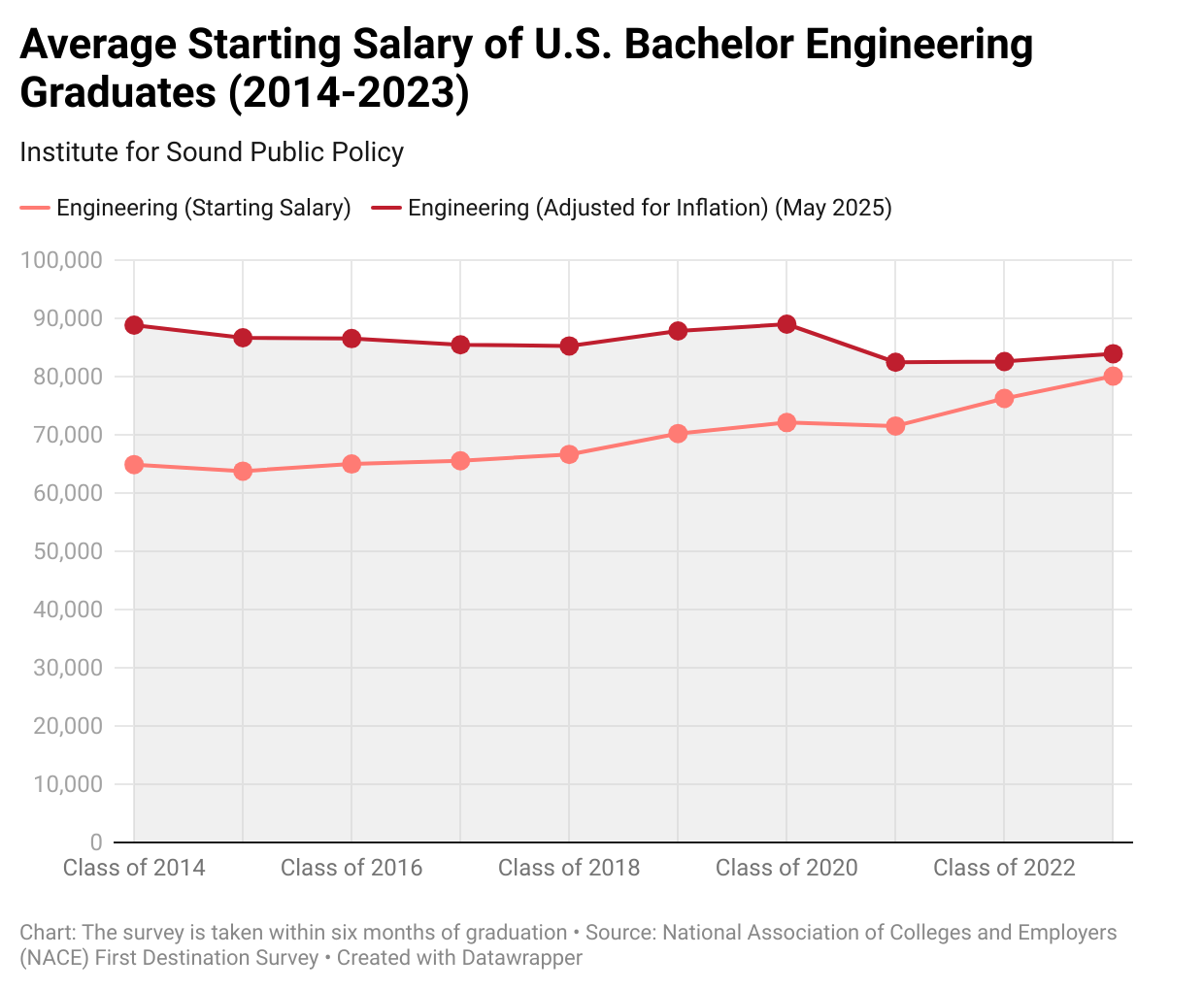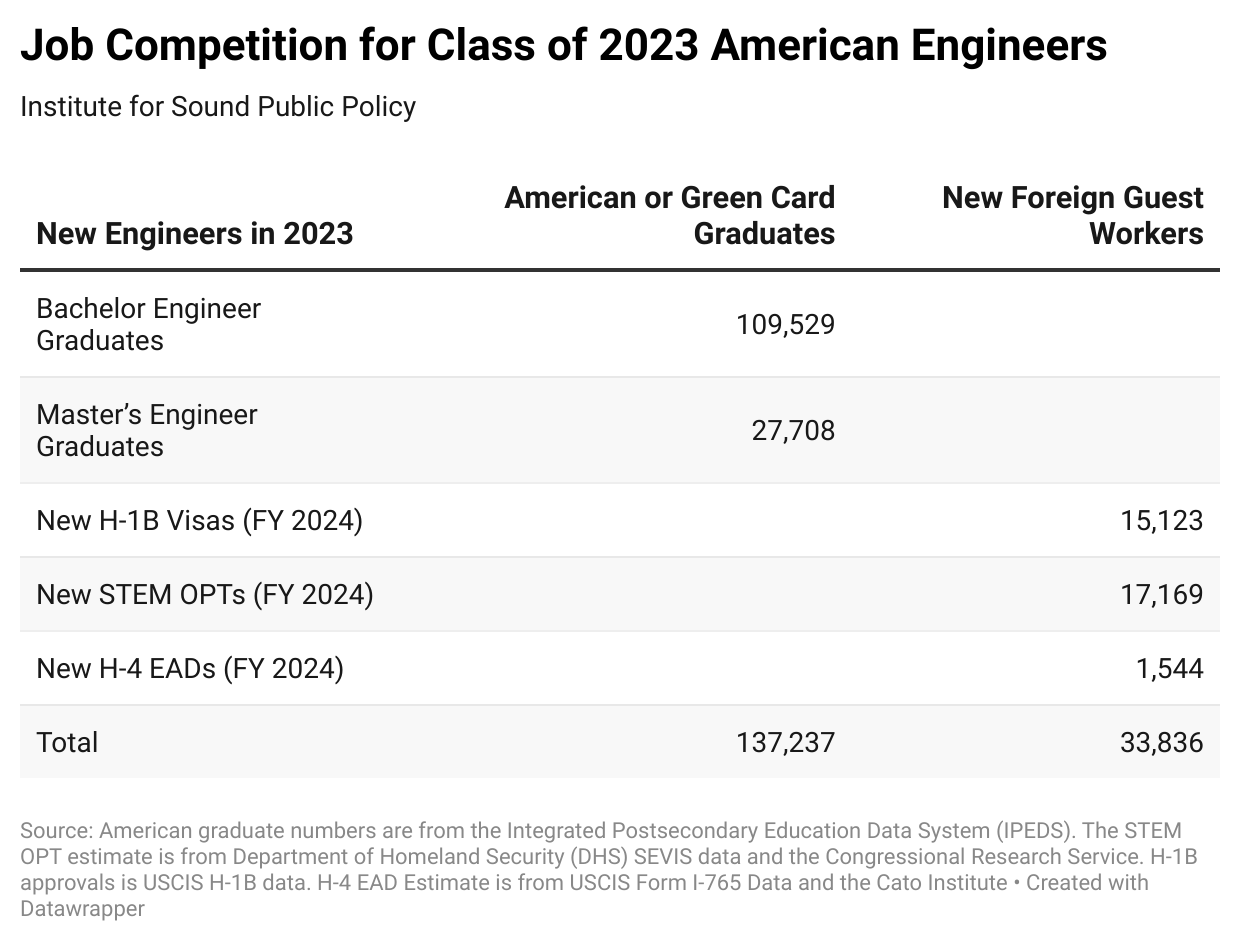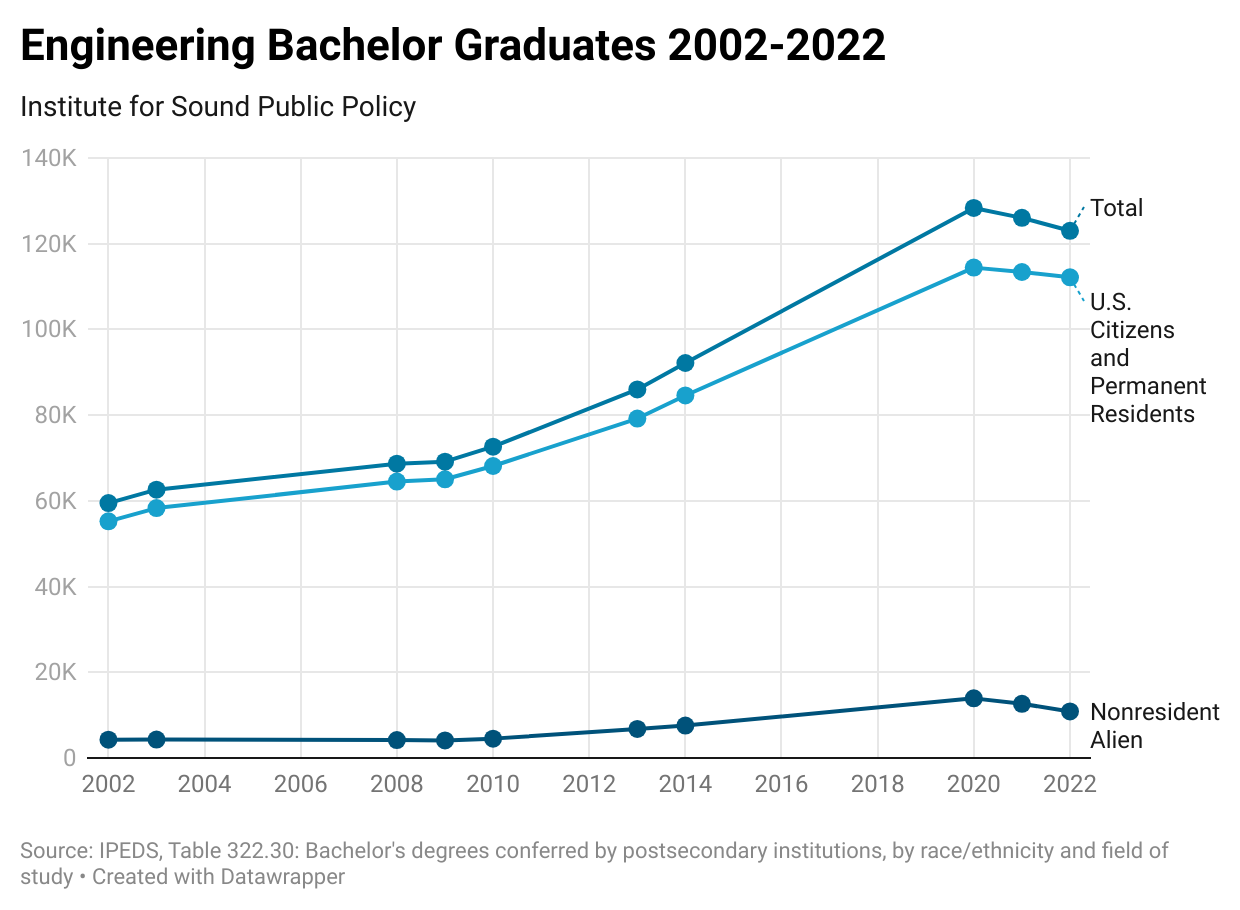Data on Why American Engineering Graduates Are Losing Ground
For decades, engineering has been sold as the golden ticket to middle-class prosperity—a field where hard work, technical skills, and innovation would guarantee stable, well-paying careers. Yet the latest data for the Class of 2023 reveals a troubling reality: American engineering graduates are facing stagnant wages, fewer job opportunities, and fierce competition for jobs from foreigners in the country on work visas and employment authorizations, all leading to an increasingly difficult path to employment in their chosen field.
The numbers paint a stark picture that contradicts the narrative of engineering as a guaranteed path to success.
The Real Wage Stagnation Reality
The National Association of Colleges and Employers (NACE) First-Destination Survey, which surveys over half a million American graduates annually, reveals that engineering salaries have nominally increased over the past decade. Average starting salaries for U.S. bachelor's engineering graduates rose from $64,891 in 2014 to $80,085 in 2023—a 23.4% increase that sounds impressive until you account for inflation.
When adjusted for purchasing power, that 2014 salary is equivalent to $88,837 in today's dollars. The current $80,085 starting salary in 2023, adjusted for inflation, is worth only $83,928—representing a real wage decline of 5.9%. American engineering graduates are actually earning $4,910 less in real terms than their counterparts from a decade ago.
This isn't progress; it's regression. While other sectors have seen meaningful real wage growth, engineering graduates are watching their economic prospects deteriorate.
The Employment Challenge
The employment picture is equally troubling. Despite the perception that engineers are in high demand, only 64.5% of engineering graduates in the Class of 2023 secured full-time employment within six months of graduation, according to NACE. 19% are continuing their education, and nearly 10% are still actively seeking work. Additionally, according to the New York Federal Reserve's analysis of Census Bureau data, 16 to 20% of recent engineering graduates are underemployed—working jobs that don't require a college degree.
Perhaps most damning is the long-term trend: research shows that only half of engineers who graduated between 1993 and 2013 actually ended up working as engineers. This suggests a systemic problem where the engineering pipeline is producing far more graduates than the market can absorb in engineering roles.
New Domestic and Foreign Supply of Workers
While American engineering graduates struggle with stagnant wages and limited job opportunities, they face an additional challenge that receives insufficient attention: intense competition from foreign guest workers who are systematically imported to fill engineering positions.
The scope of this competition is staggering. In 2023, while America graduated 137,237 citizen engineers with bachelor's or master's degrees, the federal government simultaneously approved at least 33,836 foreign guest workers with engineering backgrounds through just three major guest worker programs.
The H-1B Employment Visa
The H-1B visa program alone approved 15,123 new petitions for engineers in fiscal year 2024.
STEM Optional Practical Training (OPT)
The STEM Optional Practical Training program, which allows international students to work for up to three years after graduation, authorized an estimated 17,169 new engineering positions in 2023. 18% of foreigners authorized for OPT major in engineering.
H-4 EAD Program
An estimated 1,544 engineers received work authorization in fiscal year 2024 through this program for spouses of H-1B workers. 6% of all H-4 EAD holders are engineers.
This means that foreign guest workers equaled at least 25% of the entire American engineering graduating class of 2023—a massive influx of competition that directly impacts wages and employment opportunities for American graduates.
American Engineer Supply
I have been citing 2023 numbers, but it is not just about the class of 2023. As the above chart demonstrates, it is also the Class of 2022, 2021, 2020, 2019, 2018, etc. The total number of American engineering graduates doubled in the last twenty years, with Americans making up 90-95% of each graduating undergraduate class. Each graduating class has faced increasing competition for a limited number of engineering jobs.
The Path Forward
The solution isn't to abandon engineering. The solution lies in enacting policies that prioritize American workers and students over corporate or employer interests.
Meaningful reform would start with suspending or dramatically reducing guest worker programs that directly compete with American engineering graduates. If we eliminated just one year's worth of H-1B, STEM OPT, and H-4 EAD engineer approvals, it would automatically tighten the labor market and open up slots to 25% of the Class of 2023, improving wages and employment prospects for American graduates.
Additionally, if graduates aren't finding engineering jobs at competitive wages, universities should be held accountable for the real employment outcomes of their programs.
Conclusion
American engineering graduates face a perfect storm of wage stagnation, artificially limited job opportunities, and policy-driven competition that systematically undermines their prospects.
The choice is clear: we can continue current policies that prioritize cheap labor for employers over opportunities for American students, or we can reform our approach to prioritize the workers we've already invested in educating.
The data doesn't lie. The question is whether policymakers will listen to it—or continue to ignore the struggles of an entire generation of American engineers.
P.S.
In the coming months, we will be publishing a series of articles on American student outcomes in STEM fields. Stay tuned for our next article on computer science graduates, which is even more alarming.
We are doing this data-based series because our youngest, best, and brightest should be protected from the harmful aspects of anti-American citizen policies that, in the long run, hurt the national interests. If you agree, go to our donation page and send some dollars or bitcoin our way.
Here’s the link:
https://instituteforsoundpublicpolicy.org/donate/
Data Sources
Engineer Starting Salary Data
https://www.naceweb.org/job-market/graduate-outcomes/first-destination/
American Engineer Graduates Data
https://nces.ed.gov/ipeds
H-1B Data
STEM OPT Work Permit Data
https://www.ice.gov/doclib/sevis/btn/25_0605_2024-sevis-btn.pdf
STEM OPT Engineer Data
https://www.congress.gov/crs-product/IF12631
H-4 EAD Data
https://www.cato.org/blog/facts-about-h-4-visas-spouses-h-1b-workers







Thank you. Science and engineering unemployment and underemployment is a long-term U.S. problem. I earned my B.S. as a scientist in 1973. It was very challenging to find a position because so many engineers had their positions cut after the successful Apollo 11 landing on July 20, 1969. That was one of my motivations for continuing my education. However, the widely-promoted employment surveys were biased to not show the true level of science and engineering unemployment and underemployment (a problem that persists 52 years later!)
With great secrecy, the Association of American Universities (AAU) lobbied U.S. Representative Joshua Eilberg (D-PA) via undisclosed means to make a consequential change in U.S. immigration law in 1976, colloquially referred to as the "Eilberg Amendment." See https://theportal.wiki/wiki/Eilberg_Amendment_(1976) for an in-depth explanation by Eric Weinstein, Ph.D. Using this phrase will also reveal some of my writings on this arcane legislation. This change had the effect of granting to colleges and universities the ability to hire unlimited numbers of H-1 Visa beneficiaries who had previously been international students. (This privilege persists until today. The Eilberg Amendment was cited as legislative precedent for the passage of the controversial H-1b Visa in 1990.) I had entered graduate school three years earlier. I earned my Ph.D. in 1984 in radiation biophysics. The Eilberg Amendment turned my Ph.D. into a document that branded me as "overqualified" in the eyes of many prospective employers. Since 1984, I've been dangerously close to homelessness at least twice.
Excellent. You leave off 3 points:
1) OPT workers are exempt from FICA tax - SS and medicare. These are under huge pressure right now in getting enough funds to cover obligations. By giving these jobs to foreign workers, SS and medicare are further damaged.
2) OPT is a time-limited program. You only get 1-3 years on it. This is a huge advantage for many firms. Rather than having to promote people and pay them more, there is a natural "churn" which brings in more and more cheap workers. They never have to pay workers a fair wage.
3) If a person is on an H-1B, and fails to get a renewal, they can go back to school and get on OPT.